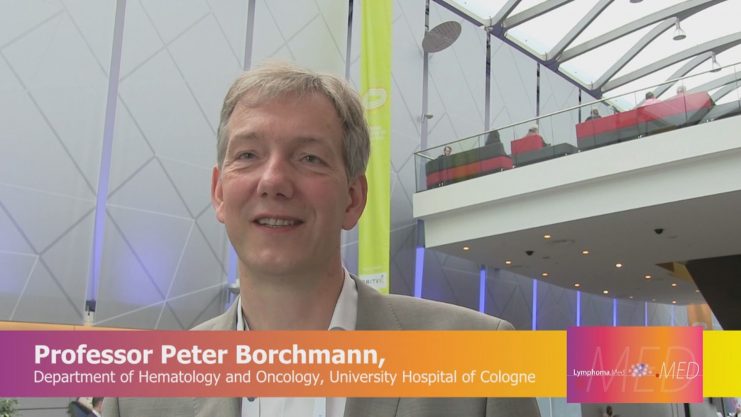Advertisment
BSH 2018: Debate: CAR-T cell therapy will become the standard of care for relapsed high-grade B-cell lymphoma within 5 years

Is CAR-T cell therapy a realistic treatment option for patients with large B cell lymphoma who otherwise have no curative options or an expensive new treatment that is complex to administer and offers little outcome advantage?…
Article by Christine Clark. Interviews by Alex Burton.
Professor Peter Borchmann (Cologne) and Dr Stephen Robinson (Bristol) discuss the arguments they presented for and against, the motion that ‘CAR-T cells will become the standard of care for relapsed high-grade B-cell lymphoma within 5 years’.
For the motion: Professor Peter Borchmann (Cologne, Germany)
The treatment of relapsed or refractory (R/R) diffuse large B cell lymphoma DLBCL represents a large unmet need in the field of lymphoma management and CAR-T cell therapy, which has a relatively good safety profile, appears to offer effective treatment for this group of patients, argued Professor Peter Borchmann.
A quarter of young patients will have relapsed within three years of treatment. About 75% of patients are over 65 years at the time of diagnosis and this group has a median PFS of only four months. Refractory disease or early relapses account for 60–80% of all treatment failures in the era of R-CHOP.
Studies using cell of origin subtypes (ABC or GCB) as predictive biomarkers have also yielded disappointing results. Although the addition of ibrutinib elicited a better response in the ABC subtype it translated into a median progression free survival (PFS) of 2.02 vs 1.31 months – “no time or almost no time”, said Professor Borchmann.
Nivolumab treatment in patients who have failed ASCT or are not eligible for ASCT has resulted in similarly short periods of PFS.
Allotransplant is regarded as the standard of care, but this achieves only about 40% PFS at three years, with serious sides effects and a treatment related mortality (TRM) of 39% that is “totally unacceptable”, said Professor Borchmann.
Thus – the current treatment of relapsed high grade B cell lymphoma is unsatisfactory and calls for consideration of CAR-T cell therapy.
Yescarta (axicabtagene ciloleucel (axi-cel)) has now been approved for R/R aggressive non-Hodgkin lymphoma (NHL). In the ZUMA-1 phase II trial 73 patients with R/R DLBCL received axi-cel after conditioning with cyclophosphamide and fludarabine. Of the 51 patients with DLBCL, 47% achieved a complete response (CR) at the first assessment. As time went on more patients achieved CR although a small number of partial responders fared badly. The median PFS was about four months.
Neither steroid treatment nor tocilizumab affected efficacy. The main adverse events were cytokine release syndrome (CRS) and CNS events but these were manageable and overall the drug had a good safety profile.
Currently CART cell therapy costs $1million per patient but it will become cheaper than allo-transplantation in three years, predicted Professor Borchmann.
Against the motion: Dr Stephen Robinson (Bone Marrow Transplant Unit, University Hopital Bristol)
Speaking against the motion Dr Stephen Robinson argued that CAR-T cell therapy is prohibitively expensive, and the outcomes are not dramatically better than older treatments if intention-to-treat (ITT) analyses applied instead of per protocol (PP) analyses.
Three trials have examined the effectiveness of CAR-T cells in R/R DLBCL – JULIET, TRANSCEND and ZUMA-1. The best objective response rates (ORRs) ranged from 53–80%, and complete responses (CRs) from 40–54%, but these were based on per protocol analyses and many patients dropped out before receiving treatment (often because they died from their disease). If ITT analyses are applied, then the ORR and CR rates fall considerably – the CRs would be 25–50%. In addition, the 18-month PFS (for CAR-T cell therapy in the ZUMA-1 trial) is likely to be nearer to 32% than the published (PP) 41%, said Dr Robinson.
Another factor is the role of conditioning therapy – conceivably the treatment with lympho-depleting cyclophosphamide and fludarabine contributes to tumour reduction and therefore to the overall response. Thus the response attributable to the CAR-T cell therapy is lower than the PP analysis suggests.
Alternatives to CAR-T cell therapy include second line salvage for relapsed DLBCL, pixantrone and polatuzumab and these also resulted in CR rates (ITT) of 27–58%, much the same as the CAR-T cell therapy. This means that there are realistic alternatives to CAR-T cell therapy for this group of patients.
The published studies show that CRS and neurological toxicity can cause significant morbidity and mortality and more problems could emerge in future associated with cytopaenias and B-cell depletion.
Estimates show that about 500 patients per year could be eligible for CAR-T cell therapy; only 25–50% will benefit from the treatment at a cost of up to £1million per patient. At present, the total cost of treating the 5000 new DLBCL patients each year in the UK amounts to £88-92 million. The NHS spends £16 billion per year on medicines – CAR-T cell therapy treatment for 700 DLBCL patients could cost 1/20th of the total NHS drugs budget.
In summary, Dr Robinson said that CAR-T cell therapy was of limited benefit, expensive and not yet fully understood. It will not be the standard of care in five years but it could be an option for small numbers of patients.
Vote: for 49%; against 51%
Based on a presentation given at the British Society of Haematology 58th Annual Scientific Meeting, Liverpool, UK.





